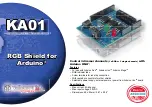
Digital Compare
Signals
Counter Compare
Signals
T ime Base
Signals
Dead
Band
(DB)
Counter
Compare
(CC)
Action
Qualifier
(AQ)
EPWMxA
EPWMxB
CTR = CMPB
CTR = 0
EPWMxINT
EPWMxSOCA
EPWMxSOCB
EPWMxA
EPWMxB
nTZ1 to nTZ3
CTR = CMPA
T ime-Base
(TB)
CTR = PRD
CTR = 0
CTR_Dir
EPWMxSYNCI
EPWMxSYNCO
EPWMxTZINT
PWM-
chopper
(PC)
Event
T rigger
and
Interrupt
(ET)
Trip
Zone
(TZ)
GPIO
MUX
ADC
VIM
Digital
Compare
(DC)
CPU Debug Mode
OSCFAIL or PLL SLip
Combination of EQEP1ERR
and EQEP2ERR
Digital Compare
Signals
Digital Compare
Signals
VIM
ePWM Submodules
2037
SPNU563A – March 2018
Copyright © 2018, Texas Instruments Incorporated
Enhanced Pulse Width Modulator (ePWM) Module
35.2.7 Trip-Zone (TZ) Submodule
shows how the trip-zone (TZ) submodule fits within the ePWM module.
Each ePWM module is connected to six TZn signals (TZ1 to TZ6). TZ1 to TZ3 are sourced from the GPIO
mux. TZ4 is sourced from a combination of EQEP1ERR and EQEP2ERR signals. TZ5 is connected to the
system oscillator or PLL clock fail logic, and TZ6 is sourced from the debug mode halt indication output
from the CPU. These signals indicate fault or trip conditions, and the ePWM outputs can be programmed
to respond accordingly when faults occur.
Figure 35-35. Trip-Zone Submodule
35.2.7.1 Purpose of the Trip-Zone Submodule
The key functions of the Trip-Zone submodule are:
•
Trip inputs TZ1 to TZ6 are mapped to all ePWM modules.
•
Upon a fault indication, either no action is taken or the ePWM outputs EPWMxA and EPWMxB can be
forced to one of the following:
–
High
–
Low
–
High-impedance
•
Support for one-shot trip (OSHT) for major short circuits or over-current conditions.
•
Support for cycle-by-cycle tripping (CBC) for current limiting operation.
•
Support for digital compare tripping (DC) based on state of on-chip analog comparator module outputs
and/or TZ1 to TZ3 signals.
•
Each trip-zone input and digital compare (DC) submodule DCAEVT1/2 or DCBEVT1/2 force event can
be allocated to either one-shot or cycle-by-cycle operation.
•
Interrupt generation is possible on any trip-zone input.
•
Software-forced tripping is also supported.
•
The trip-zone submodule can be fully bypassed if it is not required.
















































